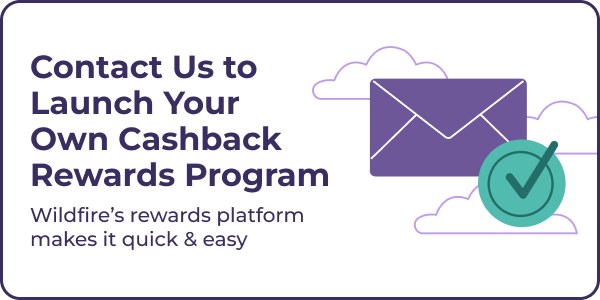At Wildfire, we're dedicated to uncovering the most effective cashback program marketing strategies to guide our clients in building data-driven and customer-centric campaigns. In previous posts, we've reviewed PayPal Honey and Capital One Shopping.
Today, we’re taking a closer look at Rakuten’s marketing strategy to understand how they engage users and leverage engagement as a tool for acquisition.
What is Rakuten?
Rakuten, formerly known as Ebates, is a popular cashback rewards platform that allows users to earn cashback on purchases made through their network of partner stores. Since being acquired by Rakuten Japan in 2014 and rebranded in 2019, Rakuten Rewards has grown to become a leader in the online cashback space, known for its focus on user engagement and retention.
Rakuten offers a browser extension, mobile app, and in-store cashback options, making it easy for users to earn cashback wherever they shop. Their primary target audience includes savvy shoppers looking for ways to save money both online and in-store.
Rakuten's Marketing Strategy: Engagement as Acquisition
Rakuten's marketing approach goes beyond traditional acquisition techniques by placing a strong emphasis on user engagement and personalization to drive growth. Here's how they effectively blend engagement with acquisition to maximize their impact.
1. Consistent and Engaging Brand Messaging

Rakuten's core message revolves around the concept of making shopping more rewarding through cashback. This simple yet powerful message is consistently communicated across all touchpoints, from ads and email campaigns to app notifications and social media posts. They emphasize their unique value proposition by highlighting big-ticket items and bold cashback percentages, creating a sense of urgency and excitement.
2. Personalization Throughout the User Journey
Rakuten uses a data-driven approach to deliver personalized offers and recommendations to users based on their shopping behavior. This personalized engagement strategy guides users through their shopping journey, encouraging repeat purchases and maximizing user lifetime value. They effectively use dynamic offers and tailored incentives to keep users engaged and motivated to shop with Rakuten.
3. Driving Repeat Purchases and Loyalty
 A significant part of Rakuten's strategy involves driving second and third purchases soon after the first transaction. By offering time-sensitive cashback boosts and personalized merchant highlights, Rakuten keeps users coming back for more. This focus on repeat engagement ensures that users stay loyal and continue to find value in the Rakuten platform.
A significant part of Rakuten's strategy involves driving second and third purchases soon after the first transaction. By offering time-sensitive cashback boosts and personalized merchant highlights, Rakuten keeps users coming back for more. This focus on repeat engagement ensures that users stay loyal and continue to find value in the Rakuten platform.
Leveraging Advocates and Influencers for Organic Growth
Rakuten capitalizes on word-of-mouth marketing by turning satisfied customers into advocates. Their referral program encourages users to invite friends and family to join, rewarding both the referrer and the new user. This strategy not only expands their user base but also builds a sense of community and trust around the Rakuten brand.
Additionally, Rakuten's partnerships with influencers and affiliates amplify their reach across various digital channels. Influencer endorsements lend credibility to their platform, attracting new users who are influenced by trusted recommendations.
Cross-Channel Marketing and Big Campaign Events
Rakuten strategically uses a combination of digital marketing tactics, including social media, email marketing, and display ads, to reach potential customers. Their large-scale campaign events like "Cash Back Day" and "Big Give Week" are designed to create buzz and attract new users through exclusive deals and increased cashback rates.
Their high-profile presence during peak shopping seasons, such as Black Friday and Cyber Monday, positions Rakuten as a go-to platform for cashback deals. By maintaining consistent messaging and a cohesive user experience across their app and browser extension, they ensure a seamless journey for all users.
Meaningful Engagement and Community Building
Rakuten goes beyond standard marketing tactics by engaging with customers on a deeper level. They respond to every user review, both positive and negative, to build trust and transparency. This approach not only strengthens relationships with existing users but also attracts new customers who value a brand that listens and responds.
Takeaways for Effective Cashback Program Marketing Strategies
Rakuten's marketing strategy is a masterclass in leveraging engagement as a tool for acquisition. Here are some key takeaways for brands looking to optimize their own cashback rewards programs:
1. Consistent Messaging: Establish a clear value proposition and reinforce it across all marketing channels.
2. Personalized User Journeys: Use data to deliver tailored experiences that drive repeat engagement and loyalty.
3. Leverage Advocates: Encourage satisfied customers to become brand advocates to boost organic growth.
4. Maximize Peak Seasons: Create impactful campaigns around key shopping periods to capture new users and drive conversions.
5. Community Engagement: Build trust by engaging directly with users and addressing their concerns transparently.
By adopting these strategies, brands can create a more engaging and effective cashback rewards program of their own, that not only attracts new users but also retains and delights existing ones.







